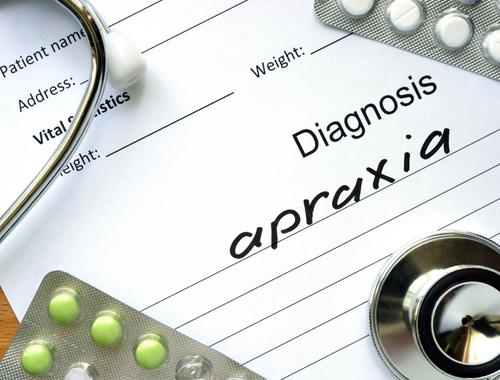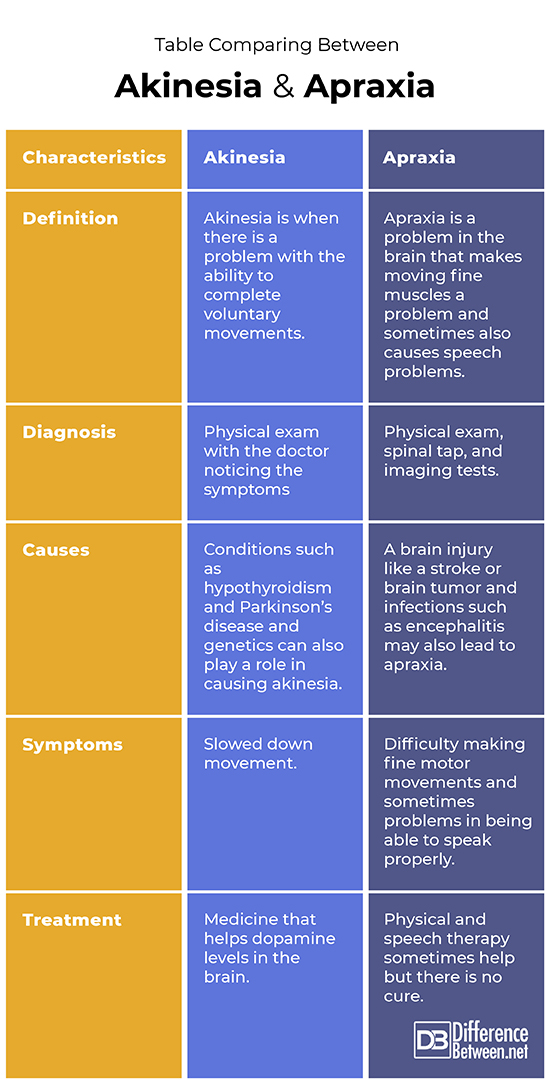Difference Between Akinesia and Apraxia
Akinesia is a disorder where people cannot control movements of the body in the way they should be able to. Apraxia is a nervous system disorder that affects people’s ability for fine motor movements and sometimes, their ability to speak.

What is Akinesia?
Definition:
Akinesia is a problem in controlling bodily movements that would normally be under conscious voluntary control.
Causes:
There are a couple of reasons why a person may develop akinesia. Illnesses of the brain such as Parkinson’s disease can result in akinesia. A lack of thyroid hormones has also been implicated as a cause of the condition. Genes can play a role in akinesia as well.
Diagnosis:
Noting the symptoms of akinesia is how doctors diagnose the problem. A doctor may suspect a fetus has akinesia if it is very small and does not move much.
Symptoms:
Akinesia typically causes people to struggle to move fast. Their movements are slowed down. When akinesia is found in fetuses, the joints contract and the lungs do not develop normally.
Treatment:
Levodopa is one of the medicines that is prescribed to treat akinesia. It helps by altering dopamine levels in the central nervous system. This in turn helps improve movement for the patient.

What is Apraxia?
Definition:
Apraxia is when a person has a problem making certain conscious actions. Apraxia can cause problems in movement, and also in speech.
Causes:
The causes of apraxia include damage to the brain such as from a stroke or tumor. In the case of a tumor that grows, the apraxia often worsens in time. Encephalitis can also affect how the brain works and can cause some apraxia as a result of the infection.
Diagnosis:
Patients are often asked to perform certain activities using fine motor skills. The ability of patients to speak is also assessed. In addition, imaging methods like MRI and CT scans of the brain may be completed to look for signs of an injury that could be responsible for the condition. A spinal tap may be done if infection in the central nervous system is suspected.
Symptoms:
There are different types of apraxia which means that the symptoms differ depending on what form the condition takes. Mostly patients with apraxia cannot easily make fine motor actions, for example, struggling to pick up a pen and write.
Treatment:
Apraxia cannot be cured, only managed. The disorder can sometimes improve if a person has a brain injury that improves. However, this is not the case in a progressive condition like a brain tumor. Sometimes physical and speech therapy can be beneficial for patients.
Difference between Akinesia and Apraxia
Definition
The definition of akinesia is a loss of the ability to move in the normal way. The definition of apraxia is difficult in fine motor control and sometimes also speech.
Diagnosis
Diagnosis of akinesia is by a physical exam noting the symptoms that the patient has; in the case of a fetus, there will be little movement and body size will be abnormally small. Diagnosis of apraxia is by physical exam and imaging tests like CT or MRI; a spinal tap may also be done.
Causes
Medical conditions like hypothyroidism and Parkinson’s disease can cause akinesia. Apraxia can be caused by infections like encephalitis or a traumatic brain injury, tumor, or stroke,
Symptoms
In the case of akinesia, the person is unable to move normally and can only move very slowly. Apraxia symptoms include difficulty performing fine motor movements and in speaking.
Treatment
Akinesia is treated using medicine that alters dopamine concentrations in the central nervous system. Apraxia can sometimes be treated with occupational and speech therapy, but it can’t be cured.
Table comparing between Akinesia and Apraxia

Summary of difference between Akinesia Vs. Apraxia
- Akinesia and apraxia are both disorders related to body movement.
- Apraxia can impact the ability to speak, specifically, being able to form a coherent sentence.
- Parkinson’s disease is a common reason why people have akinesia.
- Apraxia can happen because of a stroke or infection, or even a brain tumor.
- Treatment options are limited for apraxia while akinesia can sometimes be managed with certain medication.
FAQ
What are the 3 types of apraxia?
The 3 types of apraxia include ideomotor, melokinetic, and ideational. Ideomotor is when the person cannot make a single movement. Ideational apraxia is when a person cant finish a sequence of movements. Melokinetic apraxia is when the limbs cannot be moved to bring about precise actions.
What are the two main types of apraxia?
The two main kinds of apraxia are ideomotor and ideational.
What is the difference between dysarthria and apraxia?
Dysarthria is when the muscles involved in making sounds fail to work properly so the person cannot speak. Apraxia is more to do with the order in which words are produced to make a sentence. Apraxia is more of a neurological problem where the brain is not working as it should.
What is the difference between apraxia of speech and aphasia?
In apraxia, the person often knows the words to say but cannot say them properly in the correct order. Aphasia is when the language cannot be retrieved from the brain so the person cannot think of the words to say.
- Difference Between Rumination and Regurgitation - June 13, 2024
- Difference Between Pyelectasis and Hydronephrosis - June 4, 2024
- Difference Between Cellulitis and Erysipelas - June 1, 2024
Search DifferenceBetween.net :
Leave a Response
References :
[0]Hallett, M. "Clinical neurophysiology of akinesia." Revue neurologique 146.10 (1990): 585-590.
[1]Huang, Juebin. “Apraxia’”. Merck Manual, 2021, https://www.msdmanuals.com/professional/neurologic-disorders/function-and-dysfunction-of-the-cerebral-lobes/apraxia
[2]Ogar, Jennifer, et al. "Apraxia of speech: an overview." Neurocase 11.6 (2005): 427-432.
